William Davis's Blog: Dr. Davis Infinite Health Blog, page 100
September 11, 2016
Frankengrain

Here’s an excerpt from the Wheat Belly Cookbook about modern high-yield, semi-dwarf wheat, what I call the “Frankengrain” because of the extensive and bizarre changes introduced into this grass by geneticists and agribusiness. (Even though a cookbook, I tried to make the Wheat Belly Cookbook a standalone book that discusses the background on why and how the Wheat Belly lifestyle yields such unexpected and extravagant health and weight loss successes. For this reason, the first 90 pages of the cookbook reiterate many of the Wheat Belly basic concepts.)
From the Wheat Belly Cookbook:
Wheat encapsulates a fundamental dilemma of our technological age: How much should we permit modern agriculture to modify our food, change its genetics, alter its biochemistry—but not tell us what they did, how they did it, why they did it, and that there are potentially uncertain effects on us unwitting humans who consume it with our breakfast burrito?
If your hairdresser one day decided to give you a new hairdo and dye your curls red, surely she would discuss this with you first. If your spouse decided that life would be better in Anchorage, Alaska, wouldn’t it first come with a bit of discussion?
The production of our food does not seem to adhere to such common courtesies. Food crops and livestock are changed, you buy them, you eat them—no questions asked. The changes introduced are not just that of a new color, or an adaptation to grow under some unique condition. The food is, in many cases, fundamentally changed.
More than any other common foodstuff, wheat stands apart as the most changed. Selling bread, pretzels, or ciabattas to you under the guise of wheat is a deception that you would not tolerate in other areas of your life, certainly not from your hairdresser or spouse.
Modern wheat reflects the technological capabilities of agricultural geneticists that predate the age of genetic engineering and genetic modification, the use of gene-splicing technology to insert or delete a gene. Wheat is the brainchild of genetics manipulations that were employed before such technologies were developed. Wheat represents the product of genetic methods that were crude, often stumbling, less controllable, less predictable—far worse than genetic modification. Yes, believe it or not, modern genetic modification using gene-splicing technology to insert or delete single genes, as frightening as it may be in its implications to mess with natures’ design, represents a substantial improvement over what geneticists were doing previously.
Using breeding methods that predate genetic modification, geneticists were unable to precisely control which genes were changed, which genes were turned on or turned off, and whether entirely new and unique genetic traits were created by accident. They simply looked for the characteristics relevant to their own interests, such as shorter height or greater yield, but had no real interest in nor insight into what the total package did to humans. Why would they, since none of us ever asked?
And yet the products of these stumbling early efforts at creating “improved” genetic variations of your food are already on your store shelves. And you’ve been consuming them for something like 35 years.
The post Frankengrain appeared first on Dr. William Davis.
September 7, 2016
Natural Sleep Aides
Melatonin supplementation can hasten the onset of sleep, make sleep deeper, and discourage early awakening. It also has substantial effects in reducing blood pressure, especially when taken as a sustained-release preparation. Melatonin is not habit forming and has been proven safe, even with extended use.
People who have tried melatonin often declare that it doesn’t work, but a little finesse in its use can go a long way in obtaining the desired effect. If difficulty falling asleep is the problem, take it approximately 2 or 3 hours before the desired bedtime. If staying asleep is your struggle, then taking it right at bedtime may work better to discourage early awakening. Consider taking a time-release version for sustained effect. It also helps to experiment with different doses. While some people have wonderfully restful sleep with just 0.5 mg, others require 3, 5, 10, or even 20 mg to obtain the same effect.
Tryptophan or 5-Hydroxytryptophan Supplements
Serotonin levels in the brain can be increased by taking tryptophan or its closely related 5-hydroxytryptophan (5-HTP).
Brain serotonin levels can drop with weight loss, resulting in food cravings, low mood, irritability, anger, and argumentativeness. While the conventional medical answer is to prescribe brain serotonin– increasing antidepressant drugs, you can increase serotonin levels a natural way and reduce the negative emotions and carbohydrate cravings. Some people like the effects of these supplements so much, especially the favorable effects on mood, that they continue taking them long after the wheat and grain withdrawal is nothing more than a bad memory.
Tryptophan can be taken during the day, e.g., 500 to 1,000 mg three times per day. Alternatively, it can be taken at a higher dose once per day at bedtime to encourage sleep at a dose of 1,000 to 3,000 mg. Supplementation increases brain serotonin and melatonin, which benefits sleep at night and mood during the day. Tryptophan can be taken by itself or in combination with melatonin and tends to not leave any residual effects upon awakening. Tryptophan is most effective taken on an empty stomach.
5-Hydroxytryptophan (5-HTP) In addition to its helpfulness in reducing cravings during grain withdrawal, 5-hydroxytryptophan can also be used to enhance sleep. Supplementation has been shown to extend deep REM sleep, suggesting that sleep is deeper and more restorative with its use. As with melatonin, dose needs vary; most people take between 25 and 200 mg at bedtime.
Note that 5-HTP should not be used in combination with antidepressant medications, especially anyone taking a prescription antidepressant or carbidopa for Parkinson’s disease. This may cause an excess in serotonin levels. 5-HTP however, be used in combination with melatonin.
Yours in grainless health,
Dr. William Davis, MD
The post Natural Sleep Aides appeared first on Dr. William Davis.
September 6, 2016
Launching a new program: Undoctored U

We are launching a new project that may be of interest to anyone looking to become professionally certified in concepts relevant to Wheat Belly and the ideas that I, Dr. William Davis, advocate. We call it Undoctored U.
We call it Undoctored U because the concepts discussed are so powerful that, in a wide variety of situations, they make doctors unnecessary to reduce or reverse a wide range of health conditions. But the Undoctored U program does not treat health conditions; it corrects the factors that allow abnormal conditions to emerge in the first place—a crucial difference. It means that, if you remove the factors that allow type 2 diabetes to emerge, many people will revert back to being non-diabetic. It means that, if you eliminate the factors that allow “high cholesterol” or irritable bowel syndrome or eczema to develop, these conditions can likewise revert back to normal. All efforts are natural and fit into what I call the human “adaptive framework”: they fit into the natural human adaptive experience without prescription drugs or procedures.
Here’s an introductory video in which I explain some of the Undoctored U concepts.
The program is designed to provide certification to nutritionists, dietitians, personal trainers, physicians, chiropractors, naturopaths or anyone who wishes to gain a deeper understanding of the concepts behind Wheat Belly, the soon-to-be-released book Undoctored, and other concepts advocated by Dr. William Davis. A background in health is strongly advised, as some of the concepts are advanced and require at least some grounding in health concepts and lingo.
This is a brand-new program and the Undoctored U website and learning program is a beta-test version. Everything is operational, but you may find a glitch or two as we polish the program and all its pieces. So we are open to constructive feedback on how to make the program as powerful and effective as possible in spreading these concepts.
The post Launching a new program: Undoctored U appeared first on Dr. William Davis.
Good Sleep = Enhanced Weight Loss.
You have to face a basic health truth: If you compromise on quantity or quality of sleep, you will not lose weight. Sleep deprivation has numerous health implications beyond just crabbiness and daytime sleepiness. The physiologic disruptions of sleep deprivation include increased risk for high blood pressure, asthma, arthritis, diabetes, heart disease, and stroke.
 Lack of sleep increases cortisol and insulin, impairs the effects of insulin, and effects appetite-regulating hormones such as leptin and ghrelin. Remember, the hormone leptin is meant to shut off appetite when the physical need to eat has been satisfied. This results in an increased calorie intake of 300 to 559 calories per day.
Lack of sleep increases cortisol and insulin, impairs the effects of insulin, and effects appetite-regulating hormones such as leptin and ghrelin. Remember, the hormone leptin is meant to shut off appetite when the physical need to eat has been satisfied. This results in an increased calorie intake of 300 to 559 calories per day.
Increased calories tend to come not from increased portion sizes at meals, but from increase in snacking. –Tweet this.
Compound the increased appetite and caloric intake with the overlapping effects of opiates from grains, and you have a powerfully effective way to gain a substantial amount of weight very quickly. Adequate sleep after grain elimination is therefore crucial to gaining control over hormonal status and appetite and allows weight loss to occur.
And the less sleep you get, the worse it gets, starting with just a single night of reduced sleep. Several days per week of lost sleep can therefore yield a substantial impact on appetite and calorie intake.

3 nights a week of poor sleep can add 22 pounds of weight gain over the course of a year. –Tweet this.
How much sleep is enough for overall health and to gain control over weight?
It varies from individual-to-individual, but most people require 7 ½ hours every night. After several days of reduced sleep, a “sleep debt” accumulates that magnifies the metabolic distortions that contribute to weight gain and unhealthy effects. One night of adequate sleep does not fully pay down the sleep debt. Several days of full sleep beyond the usual 7 ½ hours may be required to normalize glucose, insulin, cortisol, and leptin distortions.
 Normal, uninterrupted sleep occurs in 90-minute cycles (e.g., 6 hours, 7 ½ hours, 9 hours) that allow your brain to cycle through all sleep phases, from light sleep to the deepest phases, including rapid eye movement (REM) sleep filled with dreams. Because it’s best to adhere to this normal cycling of sleep, set your clock or alarm to a quantity of time that adheres to this rhythm, as it will increase daytime alertness and mood.
Normal, uninterrupted sleep occurs in 90-minute cycles (e.g., 6 hours, 7 ½ hours, 9 hours) that allow your brain to cycle through all sleep phases, from light sleep to the deepest phases, including rapid eye movement (REM) sleep filled with dreams. Because it’s best to adhere to this normal cycling of sleep, set your clock or alarm to a quantity of time that adheres to this rhythm, as it will increase daytime alertness and mood.
There are also several devices now available that can waken you gently at a set time using, for instance, increasingly bright light, sound, or vibration. Smartphone apps are also appearing, often coupled to a device (such as the Lark wristband or the UP system by Jawbone) to gently awaken you after tracking both your sleep behavior and quality over the preceding night.
Yours in grainless health,
Dr. William Davis
The post Good Sleep = Enhanced Weight Loss. appeared first on Dr. William Davis.
Good Sleep; Enhanced Weight Loss?
You have to face a basic health truth: If you compromise on quantity or quality of sleep, you will not lose weight. Sleep deprivation has numerous health implications beyond just crabbiness and daytime sleepiness. The physiologic disruptions of sleep deprivation include increased risk for high blood pressure, asthma, arthritis, diabetes, heart disease, and stroke.
 Lack of sleep increases cortisol and insulin, impairs the effects of insulin, and effects appetite-regulating hormones such as leptin and ghrelin. Remember, the hormone leptin is meant to shut off appetite when the physical need to eat has been satisfied. This results in an increased calorie intake of 300 to 559 calories per day.
Lack of sleep increases cortisol and insulin, impairs the effects of insulin, and effects appetite-regulating hormones such as leptin and ghrelin. Remember, the hormone leptin is meant to shut off appetite when the physical need to eat has been satisfied. This results in an increased calorie intake of 300 to 559 calories per day.
Increased calories tend to come not from increased portion sizes at meals, but from increase in snacking. –Tweet this.
Compound the increased appetite and caloric intake with the overlapping effects of opiates from grains, and you have a powerfully effective way to gain a substantial amount of weight very quickly. Adequate sleep after grain elimination is therefore crucial to gaining control over hormonal status and appetite and allows weight loss to occur.
And the less sleep you get, the worse it gets, starting with just a single night of reduced sleep. Several days per week of lost sleep can therefore yield a substantial impact on appetite and calorie intake.

3 nights a week of poor sleep can add 22 pounds of weight gain over the course of a year. –Tweet this.
How much sleep is enough for overall health and to gain control over weight?
It varies from individual-to-individual, but most people require 7 ½ hours every night. After several days of reduced sleep, a “sleep debt” accumulates that magnifies the metabolic distortions that contribute to weight gain and unhealthy effects. One night of adequate sleep does not fully pay down the sleep debt. Several days of full sleep beyond the usual 7 ½ hours may be required to normalize glucose, insulin, cortisol, and leptin distortions.
 Normal, uninterrupted sleep occurs in 90-minute cycles (e.g., 6 hours, 7 ½ hours, 9 hours) that allow your brain to cycle through all sleep phases, from light sleep to the deepest phases, including rapid eye movement (REM) sleep filled with dreams. Because it’s best to adhere to this normal cycling of sleep, set your clock or alarm to a quantity of time that adheres to this rhythm, as it will increase daytime alertness and mood.
Normal, uninterrupted sleep occurs in 90-minute cycles (e.g., 6 hours, 7 ½ hours, 9 hours) that allow your brain to cycle through all sleep phases, from light sleep to the deepest phases, including rapid eye movement (REM) sleep filled with dreams. Because it’s best to adhere to this normal cycling of sleep, set your clock or alarm to a quantity of time that adheres to this rhythm, as it will increase daytime alertness and mood.
There are also several devices now available that can waken you gently at a set time using, for instance, increasingly bright light, sound, or vibration. Smartphone apps are also appearing, often coupled to a device (such as the Lark wristband or the UP system by Jawbone) to gently awaken you after tracking both your sleep behavior and quality over the preceding night.
Yours in grainless health,
Dr. William Davis
The post Good Sleep; Enhanced Weight Loss? appeared first on Dr. William Davis.
August 30, 2016
Having the right tools makes every task easier!
A few weeks ago I introduced you to what I call “the most effective weight-loss tool ever invented.” This dual-purpose tool is a must for monitoring ketones as well as glucose levels: A Do-It-Yourself Glucose Meter.
As many of you have heard me say before, the ideal way to manage carbohydrate intake for your unique level of metabolic tolerance is to perform finger-stick blood sugar tests. You are striving to see no change in blood sugar.
Test prior to eating and then 30 to 60 minutes after starting. – Tweet this.
This is also the best tool for monitoring your ketone level. The only difference is in timing, as ketone checks can be performed at any time, unlike the after-meal checks for blood sugar. Most people test ketones first thing in the morning, which approximates the highest value for the day. At the moment, the Abbott Precision Xtra is the only device that allows testing for both blood sugar and ketones. However, to test ketones, you’ll need to obtain ketone test strips and beware they can be pricey, around $4.00 per strip.
 Many people are frightened at the prospect of getting their blood checked for anything, and they are particularly frightened by the prospect of checking it themselves. They’re frightened that it could be painful or expensive, or that it would make them feel like they have diabetes. Have no fear!
Many people are frightened at the prospect of getting their blood checked for anything, and they are particularly frightened by the prospect of checking it themselves. They’re frightened that it could be painful or expensive, or that it would make them feel like they have diabetes. Have no fear!
As diabetics and anyone else comfortable with checking blood sugars will attest, the process is easy. It is not painful. The devices used to prick the finger are spring-loaded and cause minimal discomfort.
Glucose monitors are inexpensive, especially if you obtain a device and test strips from your physician, who will often just give them to you. The device manufacturers give them to physicians, since their money is made on the repeat sales of test strips. The equivalent of the cost of a nice dinner at a restaurant equals a purchase of a glucose meter and test strips for glucose and ketones.
There are a number of options out there. I’ve had good experiences with the OneTouch Ultra, Accu-Chek Aviva, Bayer Contour, and ReliOn brands.
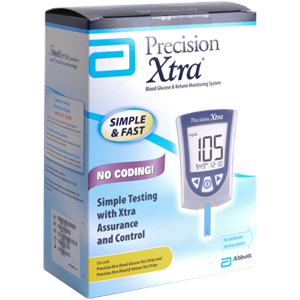
The Abbott Precision Xtra tests for both glucose and ketones, using different test strips for each. – Tweet this.
They are easy to use. Instructions are provided with each device, and it will take about 15 minutes to get any of these up and running.
It only takes minutes. Once you get comfortable with the process, it requires just 1 to 2 minutes to obtain a blood sugar or ketone value.
Yours in grainless health,
Dr. William Davis, MD
The post Having the right tools makes every task easier! appeared first on Dr. William Davis.
August 29, 2016
Maybe it’s time to check your ketone level?
Achieving ketosis is not required for most people to succeed on the Wheat Belly lifestyle. However, this can be an important issue to know about. Achieving ketosis is not just a means of accelerating weight loss, but also of enhancing mental and physical performance. You’ll experience this yourself, with heightened mental clarity, energy, and endurance in a ketogenic state.
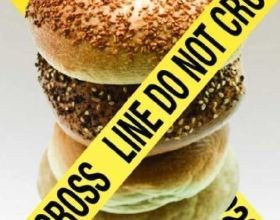 The grain-free lifestyle eliminates junk carbohydrates from the diet. – Tweet this.
The grain-free lifestyle eliminates junk carbohydrates from the diet. – Tweet this.
Some individuals find their weight loss efforts seem to plateau after some time on this diet. The occasional person will need to go the full low-carb mile and require a ketogenic state to achieve weight loss.
To achieve a ketogenic state, virtually all carbohydrates will have to be eliminated in order to metabolize fats. An effective ketogenic diet is composed of near-zero (less than 20g net carbohydrates per day) intake of carbohydrates. This is combined with a higher than usual fat intake to quell hunger and divert the metabolism toward mobilization of body fat.
You can detect ketosis by the fruity odor on the breath. – Tweet this.
This being said, there are more accurate ways to confirm a ketogenic state.
Urine can be tested using a dipstick for ketones, such as Ketostix. However, these can only detect ketones in the higher range, as are experienced by type 1 diabetics during diabetic ketoacidosis, a life-threatening state. Urine monitoring is therefore less sensitive for identifying the subtler levels of ketosis experienced physiologically, which makes urine testing inadequate for weight-loss purposes.
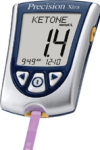 The most assured and precise method to assess blood levels of ketones is with a finger stick, just like checking blood sugar. The only difference is in the timing. Unlike the after-meal checks for blood sugar, ketone checks can be performed at any time.
The most assured and precise method to assess blood levels of ketones is with a finger stick, just like checking blood sugar. The only difference is in the timing. Unlike the after-meal checks for blood sugar, ketone checks can be performed at any time.
To maintain a ketogenic state to accelerate weight loss or break a weight-loss plateau, aim for a ketone level of 1.0 to 3.0 mmol/ L, and maintain that for as long as you desire accelerated weight loss. If you fall below this cutoff, it means that continuing carbohydrate consumption is preventing conversion to a ketogenic state.
Physicians and dietitians often warn people that ketosis is dangerous and can lead to kidney damage. This is not true. The clinical data does not demonstrate any deterioration in kidney function with high intakes of protein in people with normal kidneys.
They are confusing ketosis, a natural adaptation to periods when carbohydrates are unavailable, with diabetic ketoacidosis. Diabetic ketoacidosis is a dangerous condition that develops in type 1 diabetics who, when deprived of insulin, develop extremely high levels of blood glucose and a high level of ketones sufficient to generate a life-threatening drop in blood pH. None of this occurs in physiological ketosis generated by carbohydrate restriction in people without type 1 diabetes.
Additionally, ketosis does not necessarily require an increase in protein intake over the usual levels, but rather an increase in fat intake, which has no effect on kidney health.
Attention should still be paid to the intake of prebiotic fibers, which do not impact blood sugar or ketosis. In my view, making sure that you obtain sufficient prebiotic fibers is crucial to maximizing the benefits of a ketogenic state.
Yours in grainless health,
Dr. William Davis, MD
The post Maybe it’s time to check your ketone level? appeared first on Dr. William Davis.
August 22, 2016
“Treat” cholesterol, exorcise the bogeyman

Cholesterol panels are a source of constant confusion for many people. And most doctors are no help, having been brainwashed by marketing from the drug industry, who pass off clinical trials as “science,” studies bought and paid for by the pharmaceutical industry to drive statin drug sales, with exaggerated results reported via absurd statistical manipulations (e.g., reporting “relative risk” rather than absolute risk, a misleading way to play games with numbers, a topic to discuss in future).
Sandy shared her lipid panel 2 1/2 years into her Wheat Belly experience: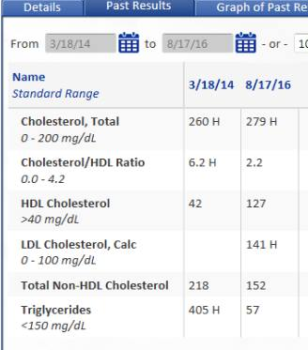
“Got some blood work done, including cholesterol. I’m confused. Not sure after 2.5 years of this WOE if I’ve improved or not. Seems some has improved, but total cholesterol went up. Can someone tell me if these results are good? I don’t fully understand the numbers. Thanks for any help!”
Of course, the rise in cholesterol prompted a discussion at the doctor’s office about whether the high cholesterol should be “treated” with a statin drug. Let’s therefore take apart what has happened to Sandy’s cholesterol panel and show why any discussion about statin drugs is unnecessary and ridiculous.
Let’s take each parameter, one by one:
HDL cholesterol–HDL cholesterol is a wonderful index of overall health and a reflection of several genetic patterns but, in general, the higher the HDL, the healthier you are, the lower the cardiovascular risk, the greater the hope for longevity. (Centenarians typically have HDL values greater than 100 mg/dl, for instance.) Sandy increased her HDL value on the Wheat Belly lifestyle from a low value of 42 mg/dl that was indeed associated with markedly increased cardiovascular risk (and I’ll bet was never once mentioned by her doctor) to an impressive 127 mg/dl—spectacular, an increase of 85 mg/dl or 300%, a level associated with incredible health, freedom from cardiovascular disease, and longevity, all achieved through the Wheat Belly strategies without drugs.
Total cholesterol–This is the high value that many doctors try to “treat” when there is nothing to treat. Of the 279 mg/dl total cholesterol, 127 mg/dl of that value is the cholesterol contained in the HDL fraction. In other words, total cholesterol went up . . . and that’s good! Besides, total cholesterol is a miserable marker for risk because it is a composite of too many variables (total cholesterol = LDL cholesterol + HDL cholesterol + triglycerides/5—a mixture of good and bad.) The most recent analyses, such as the HUNT Study 0f 52,000 Norwegians, have debunked the notion that total cholesterol is a useful marker for cardiovascular risk. There are also subsets of people who experience reduced cardiovascular risk with higher levels of total cholesterol. So what exactly is Sandy’s doctor trying to treat with drugs?
Triglycerides–Although I cringe at the inaccuracies and imprecision of cholesterol panels (as compared to superior advanced lipoprotein analyses that more confidently reveal sources of cardiovascular risk, such as NMR lipoprotein panels that I have used for 20 years), triglycerides are my favorite marker and, despite the uselessness of some of these values, is indeed a reliable and useful marker. Triglycerides reflect the level of very low-density lipoproteins, or VLDL, in the bloodstream. I therefore use triglycerides and VLDL as interchangeable terms. Triglycerides reflect a number of important metabolic phenomena, including blood sugar and insulin status (high triglycerides in type 2 diabetes, for instance), carbohydrate intake (via liver de novo lipogenesis, or the conversion of carbs to triglycerides), and volume of visceral fat that is made up of triglycerides that are continually released by fat cells into the bloodstream, then re-uptaken. (Although dietary fats are actually made of triglycerides, the contribution of dietary fat to fasting triglyceride levels is negligible, with some rare genetic exceptions. The relative contributions of carbs vs. fats in non-fasting, or postprandial, settings is an entirely different conversation.) High triglycerides/VLDL are also associated with having lots of small LDL particles, a potent cause for heart disease. Sandy dropped her high triglyceride level of 405 mg/dl, a level associated with high blood sugars, insulin resistance, lots of dietary carbs (e.g., grain amylopectin A), and lots of visceral tummy fat, to a wonderful 57 mg/dl. A triglyceride level of 60 mg/dl or less signals low VLDL levels, dramatic reduction or elimination of heart disease-causing small LDL particles, a drop in blood sugar and insulin resistance, and loss of visceral fat. In other words, the drop in triglycerides is a terrific marker for a dramatic reduction in cardiovascular risk and improvement in overall health. Once again: what exactly was Sandy’s doctor trying to treat?
LDL cholesterol–Virtually all clinical trials sponsored by the drug industry focus on LDL cholesterol as the treatment target, since even they recognize that total cholesterol is a ridiculous number of no value whatsoever. But LDL cholesterol is a value that is not even measured in most cholesterol panels, but obtained via rearrangement of the Friedewald cholesterol equation from 1960: LDL cholesterol = total cholesterol – HDL cholesterol – triglycerides/5. The equation is easy to perform but only holds if you make some assumptions. You assume, for example, that everybody eats the same diet, that nobody is diabetic or pre-diabetic, and that triglycerides make no contribution to the composition of other lipoprotein particles. All of this, of course, is patently untrue, especially when you eliminate wheat, grains, and sugars from the diet, lose weight, and incorporate practices such fish oil omega-3s and cultivate healthy bowel flora. In other words, calculated LDL cholesterol is invalid—it has no value whatsoever, as it is essentially fictitious and wildly unreliable. (Unreliable to the tune of $23 billion per year to the drug industry, however.) LDL cholesterol values, even if measured, also fail to reveal that low-density lipoprotein, LDL, particles are a widely varied collection of particle types, from small, oxidation-prone particles that last up to 7 days in the bloodstream, to large, oxidation-resistant particles that last only 24 hours. (And LDL cholesterol, like total cholesterol, is a lousy marker for risk with higher levels often suggesting lower cardiovascular risk.) To truly assess what the LDL particles measure and look like, an advanced lipoprotein analysis is required—but is never performed in drug company-sponsored clinical trials. One of the reasons for this is that the real cause for heart disease—small LDL particles—is handily reduced, typically eliminated, by diet, i.e., elimination of wheat, grains, and sugars. Dietary treatment is free and yields no pharmaceutical pot of gold. So why should Pfizer, GlaxoSmithKline, or Merck pay any attention to it?
I hope that you now appreciate how absurd it is that Sandy’s doctor, in the typical superficial and cursory way of most doctors, insisted on “treating” cholesterol. There is no basis for treatment in the values on this cholesterol panel. In truth, Sandy has improved her health immeasurably in numerous ways and her cholesterol panel, if anything, suggests dramatically reduced cardiovascular risk achieved without drugs. “Treating” cholesterol in this situation would be about as helpful as conducting an exorcism to ward off the bogeyman.
You’ll find a more extended discussion about these issues in the Wheat Belly Total Health book, specifically chapter 10, “Metabolic Mastery.” Know that statin drugs can be useful for a very small percentage of the population with specific genetic disorders and for people who make no effort to correct their diet. But the vast majority of us obtain no benefit and incur only risk (e.g., 30% increased risk for type 2 diabetes) and expense by taking these terribly over-hyped drugs.
The post “Treat” cholesterol, exorcise the bogeyman appeared first on Dr. William Davis.
August 21, 2016
Have You Checked Your Thermostat?
Another useful do-it-yourself-at-home tool can be found right in your medicine cabinet. Measuring your temperature with an oral digital thermometer can be a useful tool to help determine your thyroid status. It is another measure, like blood pressure or blood sugar, that’s a simple assessment you can perform on your own and track over time.
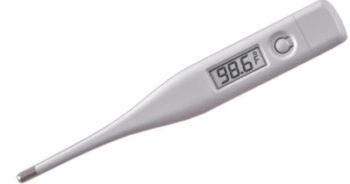 To assess and track your thyroid status, take your temperature immediately upon arising.
To assess and track your thyroid status, take your temperature immediately upon arising.
Normal oral temperature is 97.3ºF. Temperatures consistently below this suggest hypothyroidism.
Body temperature normally fluctuates within a range. Normal oral temperatures range from 96.3ºF to 99.9ºF and vary predictably with the time of day.
Body temperature undergoes predictable circadian variation. Over a 24-hour cycle, the highest temperature occurs at around 8:00 p.m. and the lowest at around 4:00 a.m. It is the temperature low that is most reflective of thyroid status.
Checking your oral temperature immediately upon awakening best approximates your thyroid status. – Tweet this!
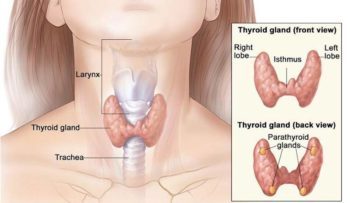 Oral temperature taken immediately upon arising that’s consistently less than 97.3ºF is suggestive of hypothyroidism; the lower the temperature, the more likely it represents hypothyroidism.
Oral temperature taken immediately upon arising that’s consistently less than 97.3ºF is suggestive of hypothyroidism; the lower the temperature, the more likely it represents hypothyroidism.
Increased body temperature suggests hyperthyroidism (as well as other conditions, including ovulation in women, exercise, and fever).
Oral temperatures are best used as a gauge of thyroid status alongside symptom assessment and thyroid lab tests that include TSH, free T3, free T4, and, ideally, reverse T3.
Temperature should not be assessed during calorie restriction, fasting, or sleep deprivation. – Tweet this!
You can use oral temperatures to also gauge the adequacy of ongoing thyroid hormone replacement. Say you take 60 mg (1 grain) of Naturethroid but your immediately-upon-awakening oral temperature rises from an average of 95.5 degrees F to 96.2 degrees F—still too low! Provided this values are at least 3-4 weeks after you began this dose (to allow full effect to develop), it suggests that a higher dose, e.g., 90 mg (1.5 grains) should be instituted.
Yours in grainless health,
Dr. William Davis
PS: Having the right tools makes every task easier! Do you have an Oral Thermometer?
The post Have You Checked Your Thermostat? appeared first on Dr. William Davis.
August 20, 2016
Is Your Thyroid Really Running the Show?
A while ago, I wrote to you about thyroid function and the role it plays in managing your metabolism. This is so important that I wanted to mention it again. If you are taking the proper steps, and have removed all of the toxic grains from your diet, but still aren’t losing the weight you desire, maybe you should consider having your thyroid checked.

Is your little thyroid sensitive?
The thyroid gland sits on the front of your throat like a miniature bow-tie. Of all endocrine glands, the thyroid gland is the most susceptible to autoimmune damage. When the immune system is unable to distinguish proteins in the colon, thyroid gland, pancreas, or brain from foreign organisms invading the body, it recruits B and T lymphocytes into an army to wage war on its own organs. We call this autoimmunity. The most common trigger of autoimmune thyroid diseases (Graves’ disease and Hashimoto’s Thyroiditis) is the gliadin protein of wheat and related proteins of other grains. Gliadin antibodies occur in 50 percent or more of people with thyroid disease.
Eliminating wheat and grains potentially removes the trigger for autoimmune thyroid damage. – Tweet this!
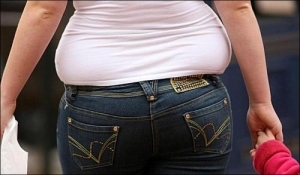 Those “Love Handles” really aren’t showing you any love! If visceral fat is present in the tummy, then this unique fat also disrupts thyroid function due to the flood of inflammatory proteins it releases that interfere with the function of thyroid hormones. This can occur with or without interference of thyroid function by autoimmune inflammation. In other words, this visceral fat is not only unattractive, it’s actually impairing weight loss.
Those “Love Handles” really aren’t showing you any love! If visceral fat is present in the tummy, then this unique fat also disrupts thyroid function due to the flood of inflammatory proteins it releases that interfere with the function of thyroid hormones. This can occur with or without interference of thyroid function by autoimmune inflammation. In other words, this visceral fat is not only unattractive, it’s actually impairing weight loss.
Is it scary out there? We are living in a dangerous era, a time when industrial compounds have proliferated to such an extraordinary degree that literally everyone is exposed to chemicals that cause some form of endocrine disruption. Disruption can occur at the brain level (hypothalamus and pituitary that control the thyroid), at the thyroid gland level, or even at the level of tissues, such as fat cells, liver, and muscle, which are all dependent on thyroid hormones.
We are living in a dangerous era, a time when industrial compounds have proliferated to such an extraordinary degree that literally everyone is exposed to chemicals that cause some form of endocrine disruption. Disruption can occur at the brain level (hypothalamus and pituitary that control the thyroid), at the thyroid gland level, or even at the level of tissues, such as fat cells, liver, and muscle, which are all dependent on thyroid hormones.
Thyroid disruption can originate with perfluorooctanoic acid residues from Teflon in your cooking, restaurant food, or groundwater. It can be caused by triclosan in antibacterial hand soaps and hand sanitizers. It can be due to polybrominated diphenyl ethers from the flame retardant in carpeting and clothing, contaminants in the water supply, and plastics that are everywhere and in everything, from cars to the lining of canned foods to water bottles. They are even in the rainwater and air we breathe.
Nobody alive today, has avoided exposure to these ubiquitous chemicals. – Tweet this!
Is it unavoidable?
Here are the numbers to prove it. The Environmental Working Group tested blood from the umbilical cords of newborns and uncovered 287 different industrial compounds, including mercury, 21 different pesticides, and components of industrial lubricants— this was in newborns, not 60-year-olds who had worked a lifetime in factories or other contaminated environments. Endocrine disruptive industrial chemicals can be detected in hair, urine, blood, liver, kidneys, and just about any other bodily fluid or organ. One recent study assessed individuals for the presence of perchlorates, a residue of synthetic fertilizers. Of 2,800 people tested, all 2,800 had detectable levels of perchlorates in their bodies.
You’ve heard that saying about death and taxes? Well, add industrial chemical exposure to the list of things that are unavoidable in life!!!
Is there a quick fix for this?
Unfortunately, there is no “detox” program that has been shown to reduce perchlorates or polychlorinated biphenyls from the thyroid gland or remove perfluorooctanoic acid residue from the adrenals. You can’t unwind the effects of fungicides like vinclozolin just by taking some purging supplement or submitting to four enemas per day. The thyroid gland and its production of thyroid hormones typically do not recover from the beating, and prescription thyroid hormones are usually still necessary, even long after autoimmune inflammation has subsided.
Is your doctor missing something?
Most doctors are unaware of the above issues, unaware that the old rules for diagnosing thyroid dysfunction no longer apply due to disruption by industrial chemicals. Thyroid status that is disrupted at the hypothalamic or pituitary level cannot be diagnosed with the usual screening methods because in these cases the TSH level (normally the only lab test used to assess thyroid function) is typically normal— even if substantial hypothyroidism is present. It means that, even if doctors manage to diagnose hypothyroidism (low levels of thyroid hormone), they will only prescribe the T4 thyroid hormone but neglect to address T3, the truly active form of thyroid hormone. This results in someone taking T4 as levothyroxine (Synthroid), being told that their thyroid status is fine, yet continuing to struggle with hypothyroid symptoms such as weight gain, cold hands and feet, hair loss, depression, water retention or edema, thinning hair, disrupted bowel function, peculiar rashes, and increased cardiovascular risk due to disruption of T3 function or blocked conversion of T4 to T3 (how most T3 in the body is produced).
What can you do?
 Look for a functional medicine practitioner, a naturopath, or someone who uses a compounding pharmacy to mix individualized thyroid prescriptions (ask the pharmacist at a compounding pharmacy in your area, one that is licensed to mix its own individualized prescriptions).
Look for a functional medicine practitioner, a naturopath, or someone who uses a compounding pharmacy to mix individualized thyroid prescriptions (ask the pharmacist at a compounding pharmacy in your area, one that is licensed to mix its own individualized prescriptions).
The key is to identify a health care practitioner who is enlightened on thyroid issues if you have such symptoms or if you have been prescribed T4 without T3. The solution is usually as easy as replacing the T4 with a T4/ T3 combination preparation (such as Armour Thyroid or Nature-Throid) or adding T3 (as liothyronine or Cytomel). Taking the right combination of medications will control thyroid dysfunction. Your body will finally be released from the misguided gate keeper (your thyroid) and the weight loss will begin.
Yours in grainless health,
Dr. William Davis, MD
The post Is Your Thyroid Really Running the Show? appeared first on Dr. William Davis.
Dr. Davis Infinite Health Blog
Recognize that this i The insights and strategies you can learn about in Dr. Davis' Infinite Health Blog are those that you can put to work to regain magnificent health, slenderness, and youthfulness.
Recognize that this is NOT what your doctor or the healthcare system provides, as they are mostly interested in dispensing pharmaceuticals and procedures to generate revenues. The healthcare INDUSTRY is not concerned with health--you must therefore take the reins yourself.
Dr. Davis focuses on:
--Real, powerful nutritional strategies
--Addresing nutrient deficiencies unique to modern lifestyles
--Deep insights into rebuilding the microbiome disrupted by so many modern factors
Follow Dr. Davis here and on social media and you can witness the extraordinary successes people enjoy on his programs. ...more
- William Davis's profile
- 160 followers



